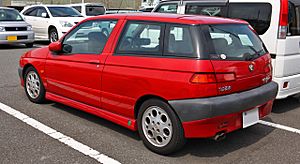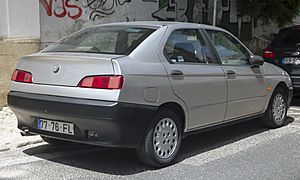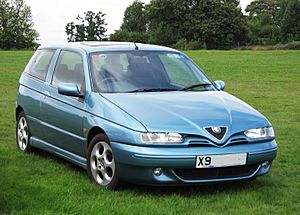Alfa Romeo 145 and 146 facts for kids
Quick facts for kids
|
|
|---|---|

Alfa Romeo 145 Quadrifoglio
|
|
| Overview | |
| Manufacturer | Alfa Romeo |
| Production |
|
| Assembly | Italy: Pomigliano d'Arco plant, Campania |
| Designer |
|
| Body and chassis | |
| Class | Small family car (C) |
| Body style |
|
| Layout | Front-engine, front-wheel-drive |
| Platform | Type Two |
| Related |
|
| Powertrain | |
| Engine |
|
| Transmission | 5-speed manual |
| Dimensions | |
| Wheelbase | 2,540 mm (100.0 in) |
| Length |
|
| Width | 1,712 mm (67.4 in) |
| Height | 1,426 mm (56.1 in) |
| Weight | 1,140–1,275 kg (2,513–2,811 lb) |
| Chronology | |
| Predecessor | Alfa Romeo 33 |
| Successor | Alfa Romeo 147 |
The Alfa Romeo 145 and Alfa Romeo 146 are small family cars made by the Italian company Alfa Romeo. They were produced between 1994 and 2000. The 145 is a three-door hatchback car, and the 146 is a five-door hatchback. The 146 was made to replace the older Alfa Romeo 33 model.
Both the 145 and 146 shared many parts, especially from the front of the car. In total, over 221,000 of the 145 models and over 233,000 of the 146 models were built.
Contents
History of the Alfa Romeo 145 and 146
Developing these cars, known as Tipo 930, took four years. They were designed to replace the older Alfa Romeo 33 in the popular family car market.
The 145 and 146 Launch
The three-door 145 was first shown in April 1994 at the Turin Motor Show. It then appeared at the Paris Motor Show in July. Sales across Europe began in October 1994.
Work on the five-door 146, or Tipo 930B, started in April 1992. It was meant to be sold alongside the 145. The 146 looked more like traditional Alfa Romeo cars and was aimed at different buyers. It was first shown in November 1994 at the Bologna Motor Show and went on sale in May 1995.
When these cars first came out, they had a 1.9-liter turbo diesel engine. They also used "boxer" petrol engines from the older Alfa Romeo 33. These petrol engines came in 1.3, 1.6, and 1.7-liter sizes. Depending on the country, cars were available in basic or better-equipped L (for "Lusso," meaning luxury) versions. The L versions had more features, especially on cars with bigger engines.
Sporty Quadrifoglio and ti Models
About a year after the first models, Alfa Romeo released sportier versions. These had a powerful 2.0-liter "Twin Spark" engine, similar to the one in the Alfa Romeo 155. These sporty models were the 145 Quadrifoglio and the 146 ti.
Both 2.0-liter versions had special features. They included more standard equipment than the L models, such as ABS (which helps prevent skidding), a leather steering wheel, and sport seats.
- The 145 Quadrifoglio (also called 145 Cloverleaf in the UK) was launched in September 1995. It had special side skirts (parts along the bottom of the car) with "green cloverleaf" badges and cool five-hole alloy wheels.
- The 146 ti went on sale in February 1996. It came with painted side skirts, a spoiler on the back, and twelve-hole alloy wheels.
These 2.0-liter cars also had stiffer suspension, better disk brakes, and wider, lower-profile tires. They also had "quick rack" steering, which made them more responsive but also made the turning circle wider.
First Updates
Starting in January 1997, the older "boxer" engines were replaced. New 1.4, 1.6, and 1.8-liter "Twin Spark" 16-valve engines were introduced.
The 1.8-liter cars received the sport chassis, steering, and brakes from the Quadrifoglio/ti models. They could also have some of the same optional features, like sport seats. At the same time, the inside of the car was updated. This included a new air conditioning system and a redesigned dashboard for left-hand drive cars.
Outside, there were only small changes, like new wheel covers and alloy wheels, and more paint colors to choose from.
In September 1997, Alfa Romeo introduced the Junior' trim level. This version was made for younger buyers. It combined the sporty look and handling of the top models with a more affordable 1.4-liter engine. Later, a 1.6-liter engine was also offered for this trim. Junior cars had the Quadrifoglio's side skirts with "Junior" badges, special 15-inch alloy wheels, and a stainless steel exhaust tip. The 146 Junior also had the tis boot spoiler.
By March 1998, the 1.8 and 2.0 Twin Spark engines were improved. They gained a little more power (4 to 5 horsepower) and reached their best power at lower engine speeds.
1999 Restyling
At the Geneva Motor Show in March 1999, Alfa Romeo showed off the updated 145 and 146 models. A new 1.9-liter "JTD" turbo-diesel engine replaced the older 1.9 TD engine. This new engine used a "common rail" system for better fuel efficiency.
The main changes on the outside were new bumpers that matched the car's color. These bumpers had round fog lights and thin protective strips. Inside, the cars got new seat fabrics and small changes like chrome rings around the air vents. Side airbags became an option, adding to the driver and passenger airbags that were already standard.
The "Junior" trim level was stopped. Instead, buyers could choose a "pack sport" option. This package included side skirts, a rear spoiler, alloy wheels, a leather steering wheel, and sport seats. These features were already standard on the 2.0-liter models. There was also a "pack lusso" option, which offered a leather steering wheel, velour seats, and mahogany wood trim.
In September 2000, Alfa Romeo launched the brand-new Alfa Romeo 147. The 145 and 146 were then replaced by the 147, which became very popular because of its great looks and improved quality.
How the Alfa Romeo 145 and 146 Were Built
The Alfa Romeo 145 and 146 were built on a special car platform called the Fiat Group's Tipo Due (Type Two). This means they had a strong, single-piece body structure. They had MacPherson strut suspension at the front and trailing arm suspension at the back.
A unique thing about these cars was that they could fit two different types of engines. Some engines were placed lengthwise (like the older Boxer engines), and others were placed across the car (like the diesel and Twin Spark engines). All engines worked with a five-speed manual transmission (a manual gearbox). The steering system was rack and pinion and had power assistance to make it easier to turn.
Performance
Here's how fast the Alfa Romeo 145 and 146 could go and how quickly they could speed up:
| Alfa Romeo 145 | |||||||||||
|---|---|---|---|---|---|---|---|---|---|---|---|
| Model | 1.4 | 1.4 TS 16V | 1.6 | 1.6 TS 16V | 1.7 16V | 1.8 TS 16V | 2.0 Quadrifoglio | 1.9 TD | 1.9 JTD | ||
| 140 PS | 144 PS | 150 PS | 155 PS | ||||||||
| Top speed km/h [mph] |
178 [111] | 185 [115] | 185 [115] | 195 [121] | 200 [124] | 205 [127] | 207 [129] | 210 [130] | 211 [131] | 178 [111] | 185 [115] |
| Acceleration 0–100 km/h (0–62 mph) |
12.5 s | 11.2 s | 11.0 s | 10.2 | 9.8 s | 9.2 s | 9.1 s | 8.4 s | 8.3 s | 12.0 s | 10.4 s |
| Alfa Romeo 146 | |||||||||||
|---|---|---|---|---|---|---|---|---|---|---|---|
| Model | 1.4 | 1.4 TS 16V | 1.6 | 1.6 TS 16V | 1.7 16V | 1.8 TS 16V | 2.0 ti | 1.9 TD | 1.9 JTD | ||
| 140 PS | 144 PS | 150 PS | 155 PS | ||||||||
| Top speed km/h [mph] |
179 [111] | 187 [116] | 187 [116] | 197 [122] | 201 [125] | 207 [129] | 209 [130] | 215 [134] | 216 [134] | 179 [111] | 187 [116] |
| Acceleration 0–100 km/h (0–62 mph) |
12.8 s | 11.5 s | 11.5 s | 10.5 s | 10.2 s | 9.4 s | 9.3 s | 8.5 s | 8.4 s | 12.5 s | 10.5 s |
See also
 In Spanish: Alfa Romeo 145 para niños
In Spanish: Alfa Romeo 145 para niños




